Multimillion-Dollar Misfortune: Total Value of Sinkhole Corvettes Is $1–$2 Million

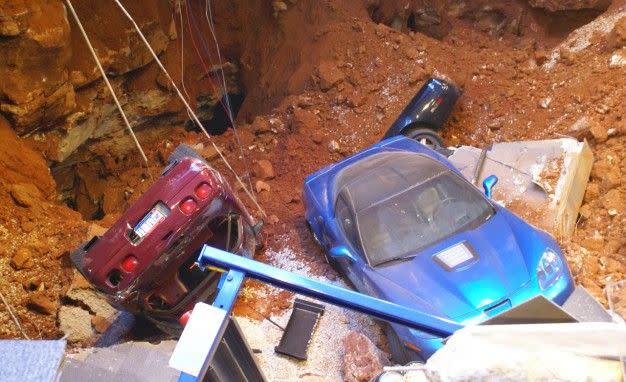
Ever hear the saying “classic cars are holes you throw money into?”
It seems that, in the coverage of the National Corvette Museum’s sinkhole incident, there are quite a few estimates for the total cost of the vehicular losses flying around, some of them true, others a bit, uh, less so (“$8 million!”). So we called classic-car insurance and valuation experts Hagerty to get the true values of the eight Chevrolet Corvettes now sitting 25–35 feet below where they were a few days ago. The most surprising news? Most of the Vettes in that hole aren’t really worth all that much—at least monetarily.
Of the eight ill-fated Corvettes, just four could be valued at six figures or more. The bulk of the others—ahem—fall into the $30,000–$45,000 range, and many also really aren’t that rare. We shall now mention that, to Corvette fans, the dollar values for each Corvette matters less than their history and restoration worthiness. (GM will oversee the cars evaluation and restoration.) Emotion aside, here’s what Hagerty told us the cars are worth on an open market—and why:
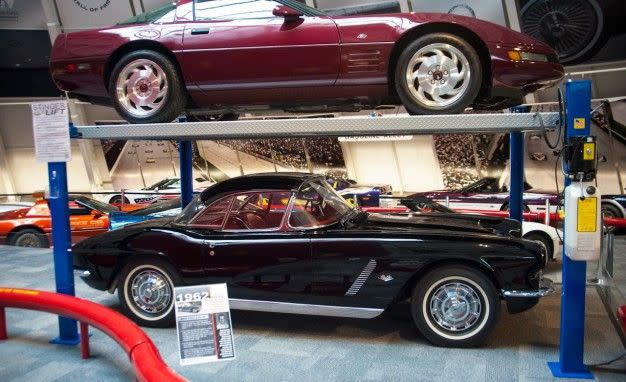
1962 Corvette: $125,000 (Maybe)
This car, Tuxedo Black with a red interior, is one of the more valuable Corvettes that fell into the sinkhole. We and Hagerty spokesperson Jonathan Klinger aren’t entirely sure whether the ’62 has the desirable fuel-injected 327 V-8—dubbed the “Fuelie”—or whether it’s a more common carbureted version, but it appears to be the former. In that case, market value is upwards of $125,000; if it’s a lesser model, it still could fetch $60,000–$80,000. Luckily, the black ’62 appears easily salvageable, having suffered seemingly minor damage in the collapse.

1984 Corvette PPG Pace Car Concept: $35,000–$45,000
At first blush, this bright-orange PPG Corvette pace car would seem like it would command big bucks—only one was built, and it paced several IndyCar races—but, as Klinger points out, it’s still an ’84 Vette. Fourth-gen (C4) Corvette prices aren’t all that high in general (some might say for good reason . . . ), so despite this particular example’s rarity, it’s still only worth $35,000–$40,000. The condition of this car is unknown, as it isn’t visible in the hole and as the security-camera footage shows, it was the first to go in.
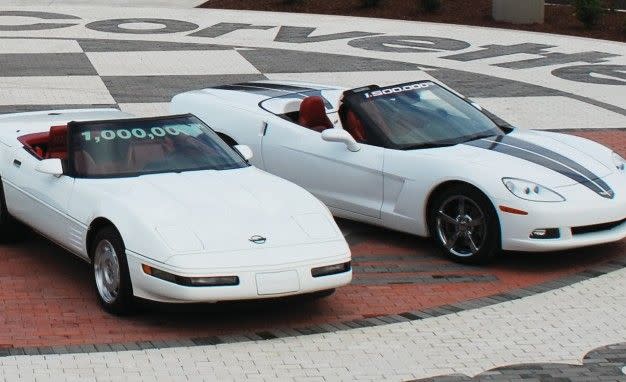
1992 Corvette Convertible (1 Millionth Corvette Built): $750,000 or More
Believe it or not, but Hagerty views this car as perhaps the most valuable ride to plunge into the sinkhole. Even though it’s more or less an average, run-of-the-mill ’92 Corvette convertible, its milestone provenance is huge—and it could bring big numbers at an auction. How much? Klinger says “healthy six figures,” but there’s a catch: The car likely would never be offered for sale. It’s simply too important to the museum and GM, so while zealous bidders could theoretically push the price past $1 million, they probably won’t ever get the chance. This car should be and will be restored, a task made easier by it not being totally buried.
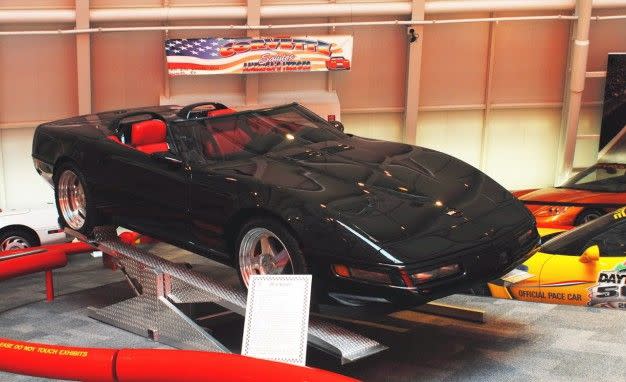
1993 Corvette ZR-1 Spyder Prototype: $250,000
Like the PPG Pace Car, the ZR-1 Spyder prototype is rare—it seems only a few were built, one of which we drove back in 1991—but unlike the PPG car, the Spyder’s very, very desirable. Chevrolet never produced a ZR-1 Spyder, and this radical show car featured the high-performance ZR-1 coupe‘s running gear, plus a radically chopped windshield and dual-cowl rear deck. Hagerty pegs the value at around a quarter of a million dollars, but adds the caveat that that price could go up or down at auction. On one hand, the rarity factor could bring crazy money, but on the other, buyers couldn’t register the car for road use thanks to its experimental VIN. Currently, only the Spyder’s left rear quarter panel is visible through mounds of earth and concrete, so file this car’s status under “TBD.”

1993 Corvette 40th Anniversary Coupe: $30,000
Corvette fans, prepare to take a bitter pill: We’re told the 40th Anniversary Corvette isn’t really worth many beans. Hagerty says this car is worth maybe $30,000, and that’s largely because of its assumed-to-be-immaculate condition—well, before it ended up upside down in a dirty hole. These cars simply aren’t that rare, and we imagine it’d be cheaper to simply buy another one than to restore the original Ruby Red example, no matter what its original condition or how light the damage may be. Still, it should be restored, simply because it will have the sinkhole incident as part of its history.

2001 Mallet Hammer Corvette: $45,000
Mr. Klinger tells us that, back in 2011, a 2002 Mallet Hammer modified Corvette went for $25,000. Given the car packs 700 horsepower, and the market has heated up in the past three years (plus inflation), Klinger says this 2001 model could pull $45,000. According to Hemmings Daily, this car, like the PPG Pace Car, was consumed entirely by the sinkhole.
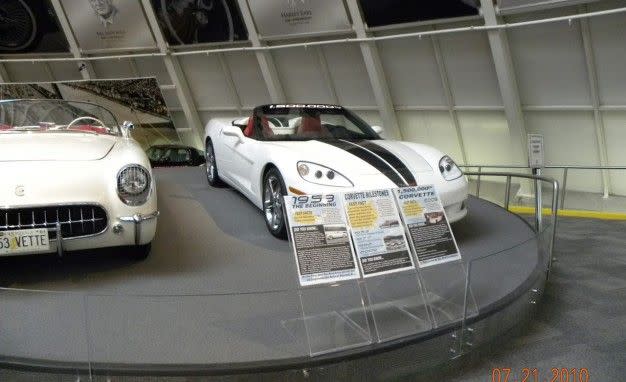
2009 Corvette Convertible, 1.5 Millionth Corvette Built: $70,000
Unlike the 1 millionth Corvette, Klinger describes the 1.5 millionth Corvette as more or less nothing special. Perhaps when the 2 millionth car is built, it could gain notoriety, but this white-over-red convertible otherwise is worth about $70,000. At least, that was before it found itself smashed beneath a slab of concrete, a fate reported by Hemmings.
Comparison Test: 2014 Chevrolet Corvette Stingray Z51 vs. Porsche 911 Carrera S
7 Things You Need to Know About the Beastly New C7.R Race Car
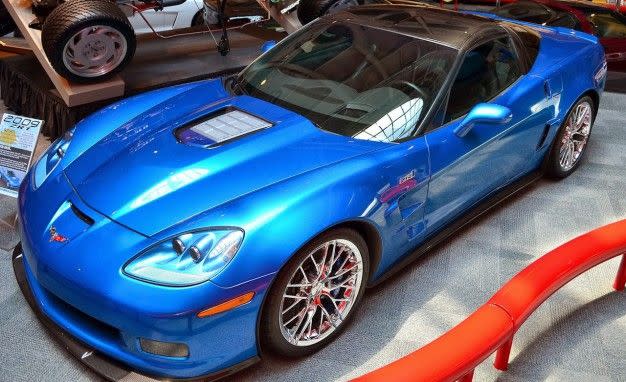
2009 Corvette ZR1 “Blue Devil” Prototype: $100,000
The Blue Devil prototype is another “wild card,” as Klinger puts it. It falls into a sort of value gray zone because of its relative youth; it certainly is a significant car—it was used for all the promotional photography leading up to the 2009 debut of the hellacious ZR1—and how many genuine ZR1 prototypes still exist? The problem is that, at the end of the day, this “Blue Devil” really is just a used 2009 ZR1 that can’t be registered for road use because of its experimental VIN. Oh, and underneath, it’s cobbled together from a 2008 Z06. As such, it could be worth $100,000 or more, but Klinger thinks that this car might not even fetch that much given its newness.
On the flip side, the Blue Devil appears almost completely undamaged, and its new “provenance” could add value. In fact, this brings us to a somewhat odd conclusion about the rest of the cars: They could all be worth more than their cumulative $1–2 million, repaired or otherwise, thanks to their notoriety. The media firestorm over this unfortunate incident means that these “sinkhole cars” have quite a compelling story. And as car collectors know well, a car’s story is everything. The National Corvette Museum certainly gets this idea, since it hopes to fully restore them allwith a little help from GM. Of course, if that doesn’t work, we have a few ideas of what to do with the cars . . .

You Might Also Like

 Yahoo Autos
Yahoo Autos 